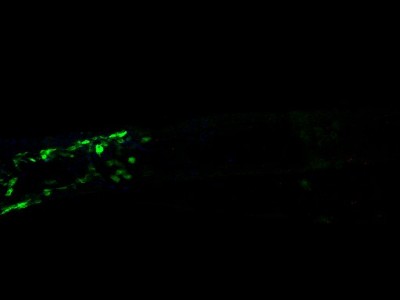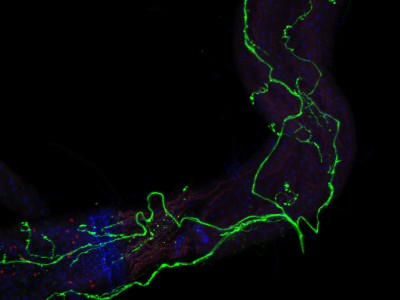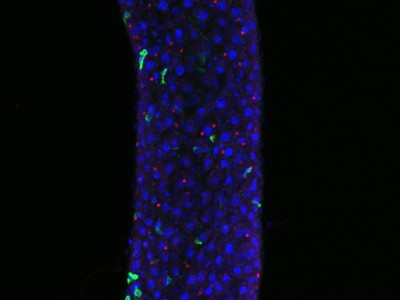건너뛰기 링크
주메뉴 및 상단메뉴
본문 및 주요 콘텐츠
Stock Search
Papers citing KDRC
- Drosophila melanogaster as potential alternative animal model for evaluating acute inhalation toxicityYoon Cho, Chul Min Park, Yong-Ju Heo, Hae-Bin Park and Min-Seok Kim
Drosophila melanogaster (D. melanogaster) is a promising model biological system. It has a short life cycle and can provide a substantial number of specimens suitable for comprehensive genetic and molecular analyses in a short time. In this study, we investigated the acute inhalation toxicity of methylisothiazolinone (MIT) and chloromethylisothiazolinone (CMIT) in a D. melanogaster model. During exposure, environmental conditions, mass median aerodynamic and geometric standard diameters were ...
- Avoiding cantharidin through ionotropic receptorsRoshani Nhuchhen Pradhan, Bhanu Shrestha, Youngseok Lee
The discernment and aversion of noxious gustatory stimuli profoundly influence homeostasis maintenance and survival of fauna. Cantharidin, a purported aphrodisiac, is a monoterpenoid compound secreted by many species of blister beetle, particularly by the Spanish fly, Lytta vesicatoria. Although the various advantageous functions of cantharidin have been described, its taste analysis and toxic properties in animalshave been rarely explored. Our study using Drosophila melanogaster examines the...
- A Novel Interaction between MFN2/Marf and MARK4/PAR-1 Is Implicated in Synaptic Defects and Mitochondrial DysfunctionYeongmi Cheon, Sunggyu Yoon, Jae-Hyuk Lee, Kiyoung Kim, Hyung-Jun Kim, Sung Wook Hong, Ye-Rang Yun, Jiwon Shim, Sung-Hak Kim, Bingwei Lu, Mihye Lee, and Seongsoo Lee
As cellular energy powerhouses, mitochondria undergo constant fission and fusion to maintain functional homeostasis. The conserved dynamin-like GTPase, Mitofusin2 (MFN2)/mitochondrial assembly regulatory factor(Marf), plays a role in mitochondrial fusion, mutations of which are implicated in age-related human diseases,including several neurodegenerative disorders. However, the regulation of MFN2/Marf-mediated mitochondrial fusion, as well as the pathologic mechanism of neurodegeneration, is n...
- Wg/Wnt1 and Erasp link ER stress to proapoptotic signaling in an autosomal dominant retinitis pigmentosa modelJung-Eun Park, Jiyoun Lee, Soonhyuck Ok, Seunghee Byun, Eun-Ju Chang, Sung-Eun Yoon, Young-Joon Kim and Min-Ji Kang
The endoplasmic reticulum (ER) is a subcellular organelle essential for cellular homeostasis. Perturbation of ER functions due to various conditions can induce apoptosis. Chronic ER stress has been implicated in a wide range of diseases, including autosomal dominant retinitis pigmentosa (ADRP), which is characterized by age-dependent retinal degeneration caused by mutant rhodopsin alleles. However, the signaling pathways that mediate apoptosis in response to ER stress remain poorly understood...
- Molecular Basis of Hexanoic Acid Taste in Drosophila melanogasterRoshani Nhuchhen Pradhan, Bhanu Shrestha, and Youngseok Lee
Animals generally prefer nutrients and avoid toxic and harmful chemicals. Recent behavioral and physiological studies have identified that sweet-sensing gustatory receptor neurons (GRNs) in Drosophila melanogaster mediate appetitive behaviors toward fatty acids. Sweet-sensing GRN activation requires the function of the ionotropic receptors IR25a, IR56d, and IR76b, as well as the gustatory receptor GR64e. However, we reveal that hexanoic acid (HA) is toxic rather than nutritious to D. melanoga...
- Taste and pheromonal inputs govern the regulation of time investment for mating by sexual experience in male Drosophila melanogasterSeung Gee Lee, Dongyu Sun, Hongyu Miao, Zekun Wu, Changku Kang, Baraa Saad, Khoi-Nguyen Ha Nguyen, Adrian Guerra-Phalen, Dorothy Bui, Al- Hassan Abbas, Brian Trinh, Ashvent Malik, Mahdi Zeghal, Anne-Christine Auge, Md Ehteshamul Islam, Kyle Wong, Tiffany Stern, Elizabeth Lebedev, Thomas N. Sherratt, Woo Jae Kim
Males have finite resources to spend on reproduction. Thus, males rely on a ‘time invest- ment strategy’ to maximize their reproductive success. For example, male Drosophila mela- nogaster extends their mating duration when surrounded by conditions enriched with rivals. Here we report a different form of behavioral plasticity whereby male fruit flies exhibit a shortened duration of mating when they are sexually experienced; we refer to this plasticity as ‘shorter-mating-duration (SMD)�...
- Molecular and neuronal mechanisms for amino acid taste perception in the Drosophila labellumBinod Aryal, Subash Dhakal, Bhanu Shrestha, Youngseok Lee
Amino acids are essential nutrients that act as building blocks for protein synthesis. Recent studies in Drosophila have demonstrated that glycine, phenylalanine, and threonine elicit attraction, whereas trypto- phan elicits aversion at ecologically relevant concentrations. Here, we demonstrated that eight amino acids, including arginine, glycine, alanine, serine, phenylalanine, threonine, cysteine, and proline, differentially stim- ulate feeding behavior by activating sweet-sensing gustatory...








